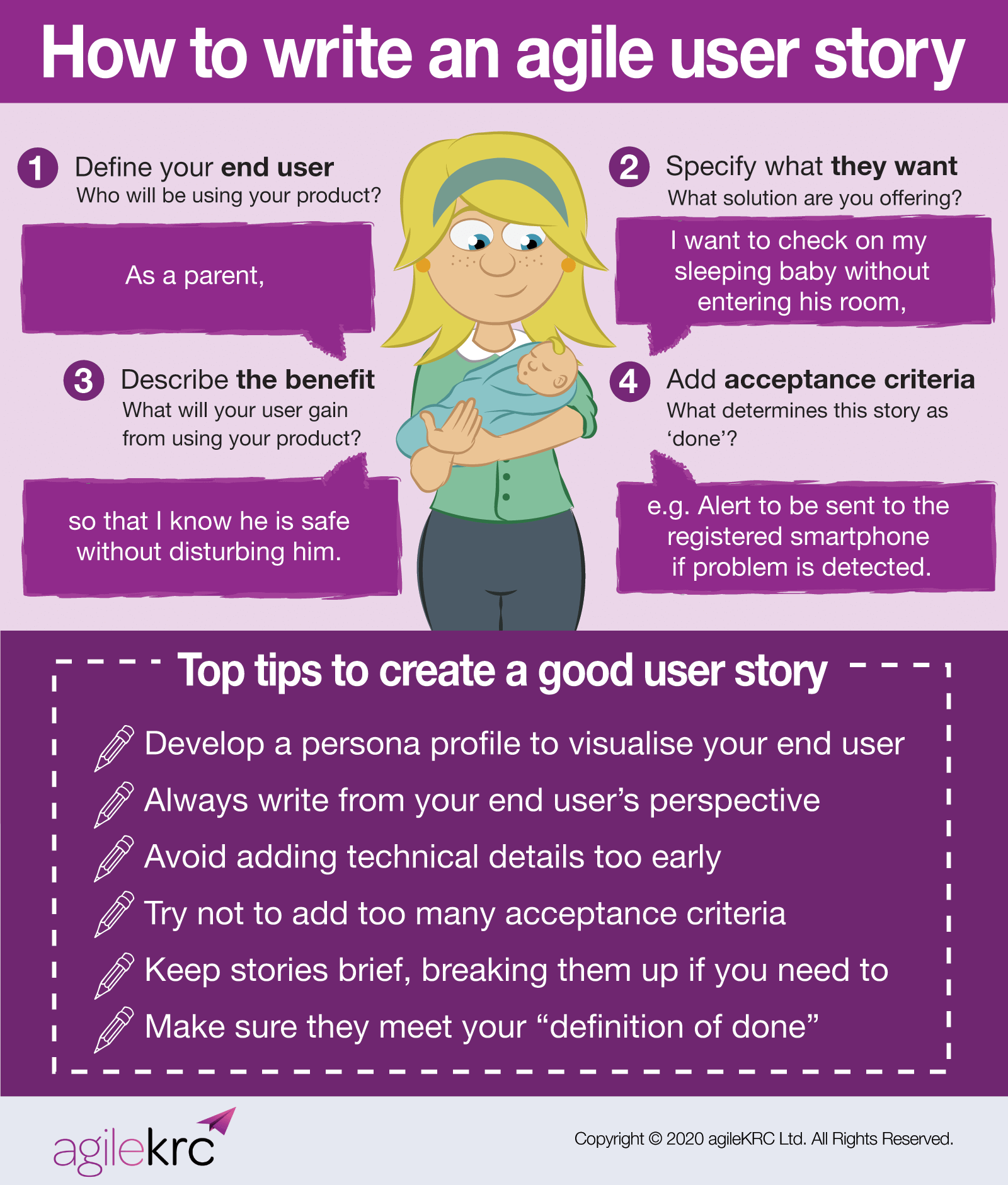
Introduction
Agile user stories are an essential part of Agile development processes. User stories help teams to understand the customer’s needs and create products that meet those needs.
An Agile user story is a brief, informal description of a feature or function of a product, written from the perspective of the user.
In this article, we will explain how to write an Agile user story that accurately captures the users’ requirements.
Understanding users’ needs
Before you start writing an Agile user story, it’s important to understand the user’s needs. To do this, you need to speak to the customer, listen to their feedback and identify their pain points. If you are working in a Scrum team, this liaison with the customer is likely to be performed by the Scrum Product Owner role.
Once you have a clear understanding of the user’s needs, you can start to write an Agile user story that addresses those needs.
Create a template
The next step is to create a template for your Agile user stories. A good template should be easy to understand, and should include the following components:
As a (user), I want (functionality), so that (benefit).
The first part of the Agile user story template is “As a (user).” This part of the template describes the user who will benefit from the feature or functionality.
For example, “As a shopper, I want to be able to browse products by category, so that I can easily find what I’m looking for.”
The second part of the Agile user story template is “I want (functionality).” This part of the template describes the feature or functionality that the user wants.
For example, “As a shopper, I want to be able to browse products by category.”
The third part of the Agile user story template is “so that (benefit).” This part of the template describes the benefit that the user will get from the feature or functionality.
For example, “As a shopper, I want to be able to browse products by category, so that I can easily find what I’m looking for.”
Use simple language
When writing Agile user stories, it’s important to use simple, easy-to-understand language. Avoid using technical jargon or complex sentences that might confuse the reader.
For example, don’t write things such as “As a user, I want to be able to integrate the API with the front-end of the application.”
Keep it focused
An Agile user story should be focused on a single feature or functionality. Avoid trying to cram too much into a single user story, as this can make it difficult to understand and implement.
For example, instead of writing “As a shopper, I want to be able to browse products by category, search for products by name, and sort products by price,” you could write separate user stories for each of these features:
- As a shopper, I want to be able to browse products by category.
- As a shopper, I want to be able to search for products by name.
- As a shopper, I want to be able to sort products by price.
Use acceptance criteria
To ensure that an Agile user story is well-defined, it’s important to include acceptance criteria. Acceptance criteria are a set of conditions that must be met in order for the user story to be considered complete.
For example, the acceptance criteria for the user story “As a shopper, I want to be able to browse products by category” might include:
- The application must display a list of product categories.
- The user must be able to click on a category to see the products in that category.
Write user stories from the user’s perspective
An Agile user story should be written from the perspective of the user. This means that you should focus on what the user wants to accomplish and the benefit that they will get from using the feature or functionality.
For example, instead of writing “As a developer, I want to optimize the search algorithm to improve performance,” you could write “As a shopper, I want to be able to quickly find the products I’m looking for when using the search feature.”
Prioritize User Stories
When writing Agile user stories, it’s important to prioritize them based on their importance and the value they will bring to the customer. The most important user stories should be worked on first. By doing this, the agile team can deliver the features of highest value to the customer first, which means that they can deliver value early in the project.
One way to prioritize user stories is to use the MoSCoW method, which stands for:
- Must have
- Should have
- Could have
- Won’t have
Must have user stories are essential and must be included in the product. Should have user stories are important, but not essential. Could have user stories are nice to have, but not critical. Won’t have user stories are not important and will not be included in the product.
For example, if you were working on an e-commerce website, the following user stories might be prioritized using the MoSCoW method:
Must have
As a shopper, I want to be able to add items to my shopping cart and check out.
Should have
As a shopper, I want to be able to search for products by keyword.
Could have
As a shopper, I want to be able to see related products when browsing a product page.
Won’t have
As a shopper, I want to be able to customize the layout of the website.
Keep User Stories Small
Finally, it’s important to keep Agile user stories small and manageable. Small user stories are easier to understand, implement and test. This allows the development team to make rapid progress and deliver features more quickly.
For example, instead of writing “As a shopper, I want to be able to buy products using a mobile device,” you could write “As a shopper, I want to be able to view my shopping cart on my mobile device.”
Summary
In summary, Agile user stories are an essential part of the Agile development processes. They help teams to understand the customer’s needs and create products that meets those needs.
When writing Agile user stories, it’s important to understand the user’s needs, use a clear and simple template, keep the user stories focused, use acceptance criteria, write from the user’s perspective, prioritize user stories, and keep user stories small.
By following these best practices, you can create Agile user stories that are well-defined, easy to implement, and provide real value to the customer.
Infographic

agileKRC has helped shape agile thinking by leading the teams that developed AgilePM® and PRINCE2 Agile®. We take a practical, success-oriented approach. We begin by taking the time to listen and understand your needs, before offering our real-world experience and expert guidance.

